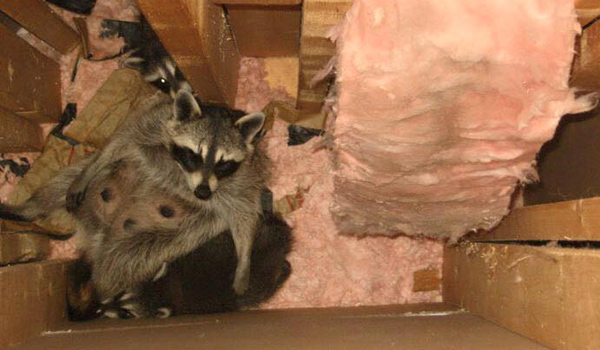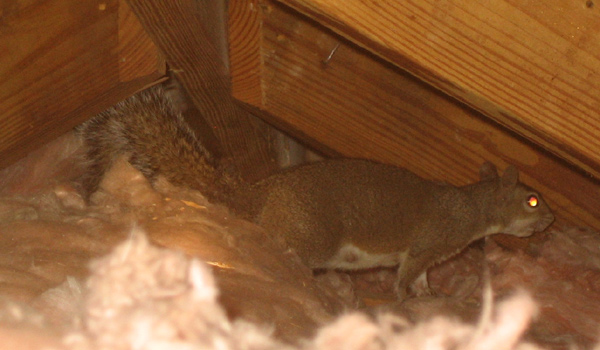- info@wildlifeanimalcontrol.com
Call us for help in your town
Wildlife Control Education
Scratching Sounds in the Attic or Walls - Animals
Most times, the strange noises and sounds coming from hidden places in a home is the first indication that some uninvited house guests have moved in, and may just be getting comfortable. Many furry animals and birds enter houses through any small opening in search of food and shelter, and when they do locate these needs they simply stay put. Animals that are known for these scratching sounds are rats, mice, bats, birds, raccoons, squirrels, and chipmunks.
Need rat removal in your hometown? We service over 500 USA locations! Click here to hire us in your town and check prices - updated for year 2020.
I will now discuss some of the common animals that make scratching noises in your walls or attic of your house. They also make running or scampering noises, or thumps, or rolling sounds. You can hear their feet or claws. Sometimes it sounds like scratch sounds, sometimes like pitter patter sounds. You know it's an animal, but it helps to know which wild animal or wildlife is making the noise.

Bat scratching sounds:
bats frequently get stuck in the walls after gaining entry into a home. In the process of trying to get unstuck, they make scurrying and scratching noises that can be heard through the wall. Being nocturnal animals, bat scratching sounds are mostly heard at night. They usually migrate to warmer regions in the winter months, but those that do not will seek warm shelter to wait out the cold winter. Thus, bats crawl under attic insulation and they remain in a largely inactive state over winter, but if the temperature rises, they wake up and may crawl around under the insulation, making scratching noises with their claws.
Rodent sounds:
rats and mice are notorious for annoying scratchy noises in the ceiling and walls as they scurry about looking for food. They may also be harvesting the seeds, nuts, and acorns that they had stored previously in the walls. This food search mostly takes place at night when the house is quiet. Mice are also territorial animals and clawing and thumping noises may be from their fights may be heard. Squeaking is common in rats and baby mice.
Trapped birds:
birds typically enter homes in search of a place to put their nest, and they sometimes end up getting stuck in the walls or attic. Trapped birds make chipping and clawing sounds as they try to get unstuck, scratching the surroundings with flapping wings. Bird noises are mostly heard in the early morning hours.
Raccoon noises:
raccoons are notorious for making themselves comfy in your attic insulation. They are also nocturnal animals and it is common to hear them running back and forth in the attic at night and scratching the ceiling boards. Raccoons make very loud noises too.
Squirrel sounds:
squirrels typically live in trees but once they gain entrance into a home, they go ahead to get comfortable in the attic. These active animals make jumping, scurrying and scratching noises during daylight hours, and especially when entering or exiting the attic. Red and gray squirrels are heard more at day time, while flying squirrels are nocturnal, foraging mostly at night. Preferring to live in groups, squirrels make quite a ruckus in the home
Chipmunks:
usually enter the house at a lower level at or below foundation level. They are active during the day, climbing in gutters and hiding food in wall voids. They typically make loud scratching sounds as they climb gutters and walls looking to retrieve stored food. Chipmunks also make chirping sounds.
Here are links to the most common critters that make
sound in your attic, walls, or crawl space: Raccoons - Squirrels - Rats - Mice.

How to get wild animals out of a wall - While the space between your walls can be quite small, there are times when there is enough room for wildlife to get inside and build a nest. This can be an absolute disaster if it occurs. These creatures are messy and carry a wide variety of diseases and parasites that you simply can’t afford to have in your home.
You clearly want to rid yourself of these critters, but you have to be smart about it. You can’t simply open the wall, or you risk having the wildlife come into your home to make a mess. You also can’t leave it there, not only because it poses a huge health risk for you and your family, but also because it may start to dig at your walls until it finds a way into your home. That is dangerous on many levels, especially for your pets.
So how does one get rid of a wildlife that is living inside your walls? That is a good question. It starts by checking to see how the wildlife got into the wall in the first place. Somewhere around the outside of your home there must be a loose board or hole that allowed the wildlife access. You will need to know where this is at so you can close this once you have gotten the animal to leave.
If you have found it then that is great, but do not just stop there. Be safe and make sure that there is only one. Look around your home thoroughly to make sure you that you do not find an additional hole. If you do closed up one, preferably the one furthest away from where the wildlife is living.
Now it is time to get rid of the beast. Many wild animals such as rats or raccoons are nocturnal creatures, so they will start to awaken as it gets dark. When they do they will be out looking for food. This is how you will get them out. Put a very small amount of food outside their entryway maybe something like corn meal or some seeds. Now build a trail leading away for your home, at least a few hundred feet away.
As it starts to get to dusk begin to make some noise so that the wildlife will awaken and want to leave out of irritation. When it leaves out of the hole it will find the food and start to eat. As it is lead away spring into action. Seal the place the wildlife is getting in, and shine a very bright light there to keep the wildlife away. Hire a professional crew to clean inside the wall afterward.
Read more articles about how to take care of your wildlife problem. I can teach you about exclusion barriers, if it is safe to handle a wild animal with bare hands, and what is the best bait to trap a wild animal. Learn about the different causes of bad odor in a house and how to know if there are baby wild animals in the attic. Find out if you should feed a baby wild animal you found and if a wild animal in the attic will have a nest of babies. Learn from my experience if repellents will get a rodent out of the attic, an if a rodent in your attic is likely to have a nest of babies. In fact, I have years of professional experience Removing wild animals in the attic, and am happy to share my best advice on how to get rodents out of the attic and let you know what other animals like to live in attics. Find out the kind of damage animals in the attic can cause, and hoow to know if you have a wild animal in your attic. Find out if wild animals make good pets, if moth balls or ammonia help repel wild animals, how to get animals out of the chimney, and even everything you need to know about the green anole.

















